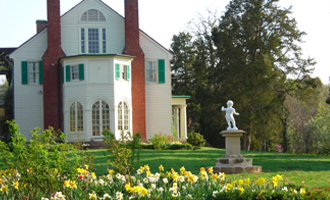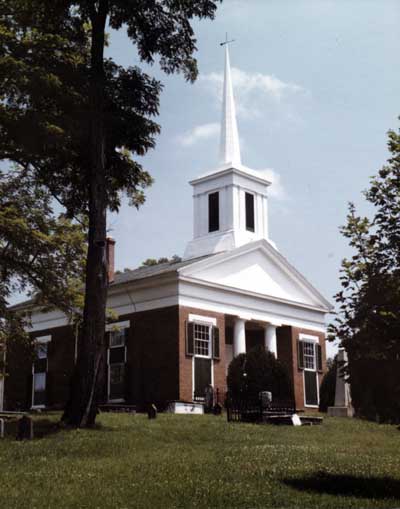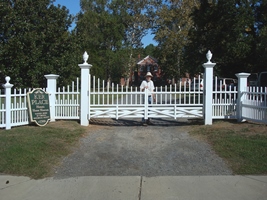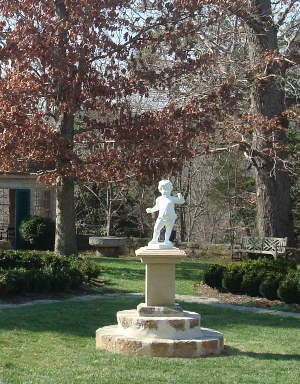|
|
| Restoration News | June 2013 |
Greetings!
We are proud to present our second newsletter which serves as an informational link between the historic properties restored by the GCV. It is hoped that the information contained herein will continue to help in sharing maintenance concerns and success stories among the properties and benefit the managers, staff, and the public who visit them.
We welcome your comments and suggestions and thank you for your commitment to maintain the properties restored by the Garden Club of Virginia around the State.
Sincerely,

Sally Guy Brown
GCV Restoration Chairman |
|
|
|
|
|
|
|
|
|
Featured Historic Gardens
Belmont, Falmouth
Just outside of Fredericksburg is Belmont, the home of the renowned artist Gari Melchers and his wife Corinne. Purchased by the Melchers in 1916, it remained their home until 1942 (Mr. Melchers died in 1931)
 | | Belmont |
when Mrs. Melchers gave Belmont to the Commonwealth of Virginia. The property is operated and maintained by the University of Mary Washington.
The original north half of the frame house was built high on a hill overlooking the Rappahannock River around 1790. The house was enlarged in several stages in the 1850s by the Joseph Burwell Ficklen family who owned the house from 1823 to 1916. It was during these years that the structure of the present garden was designed with the long walk on the east side of the house, triangular beds at either end, a circular carriage drive and a long flight of brick steps leading to the bottom of the hill.
After the Melchers took up residence, Corinne became a devoted gardener with grand plans for creating a "proper country estate." An artist in her own right, the garden became her canvas. She kept much of the basic design and added her influence through imaginative plantings of bulbs, annuals, roses, fruit trees, elms and laurels. In 1923, a stone studio/gallery was built on the property as well as a new stone entrance. She later created a new garden path through the grove and built a summer house.
In 1991, the GCV was asked to restore the garden to the 20th century "country estate" of the Melchers era. Over the years since then, the GCV has continued to make additional improvements in an effort to bring back the original Melcher garden. Corinne Melchers, a GCV member herself, would be so pleased to know her beloved garden was brought back from a long sleep. Read more...
Fincastle Presbyterian Church, Botetourt County
 | | Fincastle Presbyterian Church |
This noble little church surrounded by its graveyard was established in 1770 as an Anglican Church. It was later used by the dissenters of the Church of England after the Revolutionary War. In 1813, the local Presbyterians petitioned the General Assembly for the property to use as their church and it is maintained as such to this day. The structure has been altered over the years and went into a decline in the early twentieth century.
The Garden Club of Virginia was asked by the Roanoke Valley Garden Club in 1940 about restoring the landscape. A renewed interest by church members and citizens of Botetourt led to the removal of overgrowth in and around the churchyard revealing the extreme condition of the property. By 1944, order was restored to the site. A walkway to the front entrance was redone and a new brick wall and terrace were built. Headstones were up-righted and repaired. Plantings of climbing euonymus, Virgin's bower, crape myrtles, holly trees, magnolias and weeping willows were carefully placed in and around the churchyard.
In 1959, the GCV returned to assist landscape architect and designer of the nearby Blueridge Parkway, Stanley Abbott, with additional plantings for the new education wing of the church in keeping with the historic nature of the scene. And in 2013, a columbarium was designed by GCV landscape architect William D. Rieley for installation in the churchyard. It is also in keeping with the historic era of the church.
Today this church has an active congregation who takes great pride in the historic significance of the property while maintaining its place among GCV restored landscapes. Read more...
Ker Place, Onancock
This fine Federal home was built in 1799 - 1801 by John Shepherd Ker and his wife, Agnes Corbin Ker. Most of the houses on the shore during this time were frame houses that would support various additions as the family grew and prospered. The Ker home was most unusual in its size and construction. It stayed in the Ker/Snead family until 1875 when it was sold to George W. Powell. Three generations of Powells lived here until the house and 2 acres were sold to the Eastern Shore Historical Society in 1960. The house serves as a museum, meeting place and for special events. It is listed as a Virginia Historic Landmark and on the National Register of Historic Places.
 | | Charles Mahler, fence maker |
In 1981, the Garden Club of Virginia was asked for assistance with the landscape. There were no historical records for reference so GCV landscape architect, Rudy J. Favretti designed the landscape to enhance the setting of this grand Federal house. Two aged sycamores in front of the home became the basis of the restoration. Various trees and shrubbery flank the driveway leading to the house. A curved walkway leads to the back of the house and meets a long axial walk planted with a crape myrtle allee ending with an arbor and fence. Other plantings include St. Johnswort, lilacs, flame azaleas, rhododendron, sweetshrub, beautybush, and bayberry.
The GCV returned to Ker Place in 2010 to refine the interpretation of the landscape with a gate and fence that reflects the aesthetic form of the Federal period, the regional distinctiveness of the Eastern Shore, as well as specific Adam style details from the house at Ker Place. The double swing gate is supported by two substantial posts topped with urn shapes copied from a frieze found inside the house. This front fence and gate are free of any plantings in order to draw attention to the main attraction, the beautiful Federal style home. A different fence continues down both sides of the property reflecting an 1880s Eastern Shore design. White paint highlights and preserves both styles of fencing. Read more...
|
|
Design Notes
 | | Will Rieley |
by William D. Rieley and Beate Jensen
Restoring Belmont's Putto
The Garden Club of Virginia's relationship with Gari Melchers Home and Studio at Belmont started in 1994 and their ongoing support has been critical to the efforts of recreating the garden as Gari and Corinne Melchers knew it. The Belmont archives are rich with information that guides this effort. Photographs taken by Frances Benjamin Johnston are among the documents used to glean information about the gardens. A 1927 photograph shows the Melchers' putto in the south end of the garden. "Putto" is the Italian term for the figure of a chubby, unclad boy; it is distinguished from a cherub, by the fact that cherubs have wings and putti do not.
It is not known where the Melchers purchased the putto, or its exact age or origin. The statue is seen in photographs and paintings Gari Melchers executed when the couple lived in Egmond, Holland, and its arrival at Belmont is documented in a photo dating to 1922.
 The putto was much loved and is featured in several pictures taken in the garden. Dillon, the Melchers' long time caretaker is said to have called it "Johnnie Boy," a tradition carried on by Bill and Maxine Chandler, caretakers at Belmont from the 1960s until 2002. The putto was much loved and is featured in several pictures taken in the garden. Dillon, the Melchers' long time caretaker is said to have called it "Johnnie Boy," a tradition carried on by Bill and Maxine Chandler, caretakers at Belmont from the 1960s until 2002.
Carved from soft wood and painted white, the putto had started to deteriorate and was moved inside to protect it from the weather. Its pedestal remained in the garden and a birdbath was placed on it. The Garden Club of Virginia honored the request to return a replica to the garden so that the original could be preserved while allowing visitors to enjoy the putto as the Melchers did.
The Garden Club contacted Ross Caudill, MFA, Foundry Technician and Adjunct Faculty at Virginia Commonwealth University, who developed a plan to make a copy of the damaged original while restoring and repairing the lost features. To achieve this goal the artist started with removing the many layers of paint which obscured the details of the carved sculpture. Mr. Caudill was able to replace the missing and damaged areas using period photographs as a guide. Copes were made of each part by creating flexible molds, casting them in wax and then forming ceramic molds around the wax. Baking these pieces melted the wax and left the ceramic shells to be filled with molten bronze. The process is called "lost wax" or cire perdue and it has been done essentially this way for over four thousand years. Once the ceramic molds were broken off the bronze, Mr. Caudill welded the pieces together, expertly smoothed all the joints, and coated the surface with white epoxy paint. The base, which incorporated pieces of mill stones and stone moldings, had deteriorated as well, and mason Richard Crickenberger of R. M. Crickenberger Inc. was retained to repair the 1927 stone pedestal.
Johnny Boy one again graces and punctuates this garden as he during the Melchers' tenure at Belmont. As we have seen in this garden and others, landscape restoration is not an event as much as it is a process. Returning the putto to Belmont brings us even closer to the landscape so loved by Gari and Corinne Melchers. |
Featured Gardener
Beate Jensen, Belmont
Site Preservation Manager
The Belmont garden has benefited from Beate Jensen's devoted care since 1999 (14 years).
 | | Beate Ankjaer-Jensen |
As a student of Historic Preservation at the University of Mary Washington, she began her interest in gardening working in a part-time position at Kenmore. This led to another part-time position at Belmont and, after graduation, the position as Site Preservation Manager. The garden had undergone a GCV restoration in 1994 under Rudy J. Favretti's guidance. It was a beginning of a long process to bring the garden back to its original grand design. Over time, under Beate's care and the continuing restorations by the GCV, it has flourished with a richness and variety of flowers, plants and trees that are lush and interesting. A visitor is drawn to move through the garden to see everything. Paths lead to pleasing discoveries.
Belmont was fortunate to have letters and notes from Corinne Melchers on every aspect of her garden design. Receipts for flowers, diagrams for placement, notes to indicate additions of walkways, garden structures and plantings were available. Beate thoroughly researched, not only this information, but also the period of Corinne's garden. A "Grandmother's Garden" was the popular theme in that era. The latest plantings in and around the house restored by the GCV are just as Mrs. Melcher's designed - straight from her notes. A grand mix of blooms and plantings, an artist's delight (Corinne, herself an artist) is served up for our own delight. "If she visited the garden today, she would be pleased," says Beate.
Asked to share garden problems she has succeeded in solving, Beate reveals that "letting go of problems you cannot control such as weather, storms, pests, etc. is important to maintain your sanity. But sometimes these problems bring opportunities that we should look for and capitalize on in an ever-changing landscape."
In regard to the relationship of property and staff to the Garden Club of Virginia, Beate believes that the GCV can be a great friend. Cultivate the friendship; ask respectfully for advice and support. She understands that the contract "is a valuable gift that encourages a mutual relationship. The richness of the Belmont garden is due to the support from the GCV. Keep the conversation going."
Some gardening tips she favors - taking care of details, using good compost over the years, remembering it takes an investment of time to create a memorable historic garden and lastly, join the Southern Garden History Society to meet like-minded gardeners interested in historic garden preservation.
Beate closes with the most enjoyable part of her job, "Seeing other people, the public, enjoying the garden at Belmont," said in the spirit of a true gardener.
 | | Dainty Bess |
 | | Rose Arbor |
|
Garden Maintenance
Boxwood
Boxwood are used in many restored gardens throughout Virginia. Imported from England in the 17th century, they gained importance in colonial landscapes. A resurgence of interest began during the Colonial Revival period. A member of the genus Buxus, there are 30 species and 160 cultivars with variations based on leaf size and height of one foot to twenty feet tall. The prevailing practice is to maintain them in a shrub size and shape.
The proper way to achieve healthy small boxwood is to thin, in the fall, by cutting branches in the center of the plant to allow air and light within. This also prevents weak stems and disease and makes the plant less susceptible to breakage from snow and ice. To achieve an unchanged appearance, this cutting must be done annually by hand.
A long neglected boxwood can be returned to a more manageable state by thinning, as above, and by severely cutting back the top in the early spring. If the boxwood are extremely overgrown, it may require several years of cutting back in stages. Hedges created from boxwood may be sheared in early June, then lightly in July with all shearing completed by August or by mid-July in Zones 6 or colder. It is particularly important to keep them appropriately watered to recover from the trimming. (A reminder from the last newsletter: they should receive the equivalent of 1" of rainfall every 10 days for a soil that is moist to a depth of 12" to 18".)
English and Common, or American, box (Buxus sempervirens 'suffruticosa' and Buxus sempervirens) are the classic boxwoods used in the past and certainly used today. The "English" and "American" common names are both misnomers since neither variety is native to either England or America. These varieties are both native to the Caucasus. There are many other varieties gaining in popularity such as Buxus microphylla var. japonica 'Green Beauty', Buxus x 'Green Velvet', Buxus microphylla var. japonica 'Wintergreen', Buxus sempervirens 'Vardar Valley', Buxus sinica var. insularis 'Justin Brouwers' just to name a few. Some of the upright varieties include Buxus sempervirens 'Dee Runk', Buxus sempervirens 'Fastigiata' and Buxus microphylla 'John Baldwin'.
There are several pests that attack boxwood. Boxwood leaf miner is the most common The leaves blister from where the leaf miner larvae feed inside them from late June until the following April. The adults emerge in April to May and the cycle begins again. Defoliation may result in severe cases. Systemic insecticides are best in controlling this pest by killing the larvae inside the leaf. Apply from late June to October for best results. To kill the adult leaf miner, spray insecticides when adults are emerging using multiple applications during this time.
Boxwood psyllid is a less damaging pest that chews on new foliage creating the unsightly upward cupping of the leaves. Insecticides should be applied when new growth begins, in early to mid April. Another lesser pest is mites. Encouraged by hot dry conditions, they leave tiny spots and marks on leaves. Horticulture oil in the winter and insecticides in the summer will deter this worrisome pest. Other possible pests include red spider, scale, candle fly and wooly aphids. Insecticides and/or horticulture oil are prescribed for eradication.
A more recent and disturbing problem for boxwood is Box Blight. It is a fungus(Calonectria pseudonaviculata or cylindrocladium pseudonaviculatum or C. buxicola) first found in North America in late 2011 in Oregon and British Columbia. Europe and New Zealand have documented the fungus many years before this. It has most recently found its way to Eastern North America. Strongly resistant to many fungicides, the infection may quickly spread on the plant causing sudden defoliation. Look for brown leaf spots and dark streaks or cankers on the stems. Foliage becomes tan- colored first among the lower branches. The underside of leaves reveals the white fungal growth that carries the spores. All infected plants should be destroyed. Other precautions include checking weekly for disease, disinfecting pruning equipment, avoiding overhead irrigation, achieving good air circulation by spacing and pruning and planting and growing more tolerant varieties of boxwood.
When selecting boxwood for use in the landscape, consider all aspects of the plant - size, growth rate, shape, sun or shade tolerance, disease resistance, and how and where it is sited in the garden. Boxwood have been rediscovered as an excellent addition to garden designs especially with the new cultivars available. With good care and maintenance, they will be a long-lasting part of the landscape.
|
| In the Garden Now
In Late Spring (better late than never)
- Plant late summer and fall blooming perennials.
- Plant summer-blooming bulbs.
- Plant trees and shrubs.
- Fertilize perennials.
- Add compost mulch to shrub and perennial borders.
- Prune spring flowering shrubs after they are finished flowering.
- Check for damaging insects, diseases, or stressed plants.
- Place stakes in perennial garden and start staking process as needed.
- Get watering system in order.
- Train vines to their supports.
- At the end of the Spring season, work mulch into the soil through careful, deep cultivation.
Throughout the Summer
- Keep up with deep watering of plants and turf as needed.
- Weed shrub and perennial beds.
- Continue dead-heading flowering perennials and shrubs.
- Fertilize perennials, deciduous and needle evergreen shrubs with a complete fertilizer according to soil test recommendations.
- Apply fertilizer to late blooming perennials at the end of summer.
- Tend compost piles.
- Check garden throughout season for damaging insects, diseases, or stressed plants.
- If necessary, thatch and aerate turf in late summer.
These suggestions are taken from the GCV Garden Maintenance Manual.
|
|
Did You Know?
Newly planted trees and shrubs should not be fertilized. Later, fertilizer applications can be determined by soil testing, time of year, location, drought conditions, etc.
Wrapping and staking trees is not normally recommended. The wrappings can harbor harmful insects and diseases, while staking may inhibit the roots from establishing themselves in the surrounding soil. Staking is sometimes recommended in heavily used sites or those with steep slopes.
Please see the GCV Garden Maintenance Manual for more information on planting and caring for trees and shrubs.
|
Garden Club of Virginia Restoration Committee Maintenance Workshop
On February 5, 2013, forty gardeners and maintenance workers from the GCV Restoration properties around the state met at the GCV headquarters in Richmond, the Kent -Valentine House, for a day of lectures, lunch and networking. Members of the Restoration Committee were in attendance as well as Ann Gordon Evans, President of GCV.
Sally Guy Brown, Chairman of the Restoration Committee, welcomed our guests and gave thanks for all they do to help maintain our restored gardens as outstanding examples of historic landscape preservation. Will Rieley of Rieley and Associates, GCV Landscape Architect, started the day's lectures with a brief power point presentation on the history of the Kent-Valentine House and then proceeded on with "An Illustrated Guide to the Garden Club's Policies and Procedures." Peggy Singlemann, Director of Horticulture at Maymont, followed with "Gardening in her Footsteps and Wishing I Had Her Budget." Peggy had some great tips on how to utilize the volunteers that can help in the gardens. There were Master Gardeners in the audience who volunteer at some of the GCV Restoration sites and they are a great resource.
Our afternoon speakers were Peggy Cornett, Curator of Plants at Monticello, "Preserving Historic Plants at Monticello: Gardening and Seed Saving Then and Now" and Jack Gary, Director of Archeology and Landscapes Poplar Forest, "Restoring Thomas Jefferson's Poplar Forest Landscape." Our guest speakers were all from GCV Restoration sites and because of this, their talks reflected acknowledgment of the unique character and challenge of maintaining a historic garden.
In the evaluations which were returned, the following questions arose:
- How best to manage invasive plants used in historic landscapes in modern landscapes?
- How to meld the great strides in horticulture with the historically old?
- How to accurately restore historical records when there are no records?
- How to be historically accurate yet deal with today realities, i.e., diseases, etc.?
- Requested more information on how to research specific time periods
In future newsletters, we will answer some of these questions.
Peggy Singlemann invited all to come view the gardens at Maymont when the day ended at 2:30. The next Restoration Committee Maintenance Workshop will be held in Winter 2015. Thank you very much to all who attended, and to our terrific speakers. Many thanks to all gardeners and maintenance workers at the GCV Restoration sites, your good work is vital to our success!
Candy Crosby Member, Restoration Committee |
|
Questions from Properties
Question from Moses Myers House, Norfolk: We have a supporting group that wishes to give a bench in honor of a member. May we have a plaque on the bench?
Answer: The GCV has a policy of no plaques, signs or labels are to be placed in the gardens. These detract from the general appearance of the garden or landscape and interrupt the garden's full impact on the viewer. It is suggested that a book or wall plaque for inside the facility, listing the donors and contributions, serves the purpose of honoring the individuals or groups.
Question from Point of Honor, Lynchburg: We would like the GCV to reconsider some of the earlier decisions with regard to some plantings since some of needs are now different. Is this possible?
Answer: Yes. Gardens do change over time, with loss of trees, or growth of trees changing the landscape from shade to sun, or vice versa. Other changes occur with aging plants, unhappy plants and unfortunately sometimes lack of care. The GCV is here to make these transitions a smooth process.
|
|
|